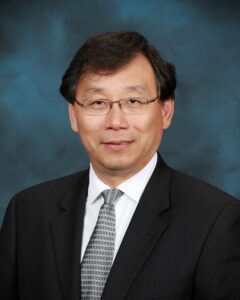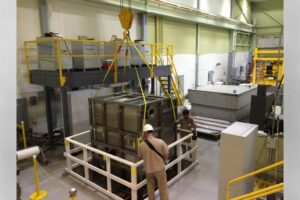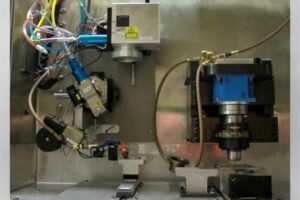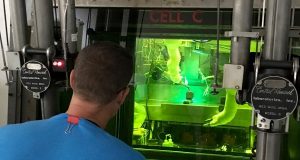

Zhili Feng Keith Leonard
Credit: Oak Ridge National Laboratory, U.S. Dept. of Energy
Scientists of the US Department of Energy’s Light Water Reactor Sustainability Program (LWRS) and partners from the Electric Power Research Institute (EPRI) have conducted the first weld tests to repair highly irradiated materials at DOE’s Oak Ridge National Laboratory.
The welding system, designed and installed in a hot cell at ORNL’s Radiochemical Engineering Development Center, safely encloses equipment for laser and friction-stir welding. It will allow researchers to advance welding technologies for repair of irradiated materials by developing processing conditions and evaluating post-weld materials properties.
As nuclear power plants age, materials that have been irradiated for several decades might require repair or replacement. Advanced welding techniques will be needed during the extended operational lives of America’s nuclear power plants; construction on most began in the 1970s. These plants generate approximately 20 percent of the nation’s electricity.
“Demonstration of advanced techniques for irradiated materials is a key step in validating weld repair as one mitigation strategy for extending the life of components and reducing costs for the nuclear industry,” said ORNL’s Keith Leonard, who leads research in the Materials Aging and Degradation Pathway for LWRS.
Mitigation strategies focus on cost-effective repairs or replacements—either may require welding. During extended operation of reactors, helium is generated through the transmutation of boron impurities by reaction with neutrons from the reactor core. Furthermore, nickel, a common alloying element in structural alloys, will also generate helium, but through a slower two-step process. Helium generation depends on the material and its location in the reactor, but for reactors exceeding 60 effective full-power years, helium generation in core components can exceed 5 to 10 atomic parts per million—levels at which traditional welding techniques cannot be used to adequately repair components.
Heat and stress drive helium to coalesce in stainless steel, forming bubbles along boundaries between ‘grains,’ or micron-scale regions of order, that weaken the material. When metal is melted and resolidifies, differences in expansion and contraction between the newly solidified material and surrounding material can build tensile stresses along the weakened, helium-bubble-containing grain boundaries, inducing cracks. “That’s the biggest problem we face with welding irradiated materials,” Leonard said. The ORNL–EPRI system uses advanced techniques that introduce less stress than conventional welding, thereby reducing cracking.
On 17th Nov, 2017, the first tests on irradiated material were performed at ORNL with a laser welding technique that uses a primary laser to weld and secondary beams to reduce tensile stresses near the weld zone. The tests were conducted on samples, known as ‘coupons,’ of irradiated stainless steel doped with 5, 10 and 20 parts of boron per million atoms. The materials were fabricated into playing-card-sized coupons at ORNL and then irradiated at the High Flux Isotope Reactor, a DOE Office of Science User Facility at ORNL. HFIR’s abundant, energetic neutrons bombard the coupons to change the boron into helium to simulate the aging that would occur in a commercial reactor after decades of radiation exposure.
21st Nov, 2017, saw the first friction stir welding of irradiated stainless steel at ORNL. Unlike conventional arc welding, which employs molten materials, friction stir welding is a solid-state mixing technique that uses a rotating tool to generate friction and heat that softens materials but does not melt them. “At the microscopic level, the atoms of each piece of material get very close, and attractive forces pull the atoms together to form one piece,” explained Zhili Feng, who leads ORNL’s Materials Joining Team. Because friction stir welding occurs below the melting point, it avoids cracking in repair welding of irradiated and helium-bearing materials. An artificial neural network monitors friction stir welding to detect conditions that can cause weld defects.
“Both repair welding technologies developed in our program are engineered to ‘proactively’ manage the stresses during welding so they potentially offer solutions for repairing [internal] reactor components with high helium levels—impossible with today’s welding repair technology,” Feng said. “As reactors continue to age (and helium continues to be generated), industry increasingly needs technologies to handle high-helium-level scenarios.”
Preliminary observations showed both techniques produced welds of good quality.
“The welding hot cell really established ORNL as a center for developing new techniques and new technologies for commercial nuclear power generation,” Leonard said. In addition to lab expertise in welding and materials characterization, ORNL strengths include diverse nearby facilities, such as other hot cells and the Low Activation Materials Development and Analysis Laboratory to support post-weld materials characterization, and HFIR to generate test material and further age post-weld materials.
Next, the researchers will explore welding materials with higher helium content and characterize the irradiated materials after they’ve been welded, with techniques including micro-structural analysis and mechanical property assessments. They will also re-age material in HFIR that has undergone a weld repair to see how further aging affects welds.
The LWRS Program conducts research and development to enhance the safe, efficient and economical performance of our nation’s nuclear fleet and extend operating lifetimes. EPRI, an independent, nonprofit organization, conducts research supporting the safe, reliable, cost-effective and environmentally responsible use of nuclear power as a generation option. EPRI is developing tools to deploy the technology to nuclear power plants for on-site repairs. Once a joint patent issues to ORNL and EPRI, companies could license the technology to make those on-site repairs.
“EPRI works broadly with researchers from companies and universities, and this case, a government lab, to address challenges in electricity, including reliability, efficiency, affordability, health, safety and the environment,” said Gregory Frederick, EPRI Program Manager. “We made a fairly large investment because we see the value for providing new knowledge that industry needs. No place has the critical mass of expertise and facilities that Oak Ridge National Laboratory provides.”
Research and development support for this project came from the US Department of Energy Office of Nuclear Energy’s LWRS Program, EPRI’s Long Term Operations Program and ORNL. DOE and EPRI shared costs for the development, design, fabrication, equipment and testing costs, and ORNL supported installation-related costs. Industry can gain access to this capability through DOE Office of Nuclear Energy funding opportunities or ORNL partnering mechanisms.
UT-Battelle manages ORNL for DOE’s Office of Science. The single largest supporter of basic research in the physical sciences in the United States, the Office of Science is working to address some of the most pressing challenges of our time.

Image 1: The High Flux Isotope Reactor at ORNL accelerated the aging of test specimens used in the welding effort to represent materials in operating commercial reactors. Image credit: Oak Ridge National Laboratory, U.S. Dept. of Energy; Photographer – Carlos Jones.

Image 2: The welding hot cell system was installed at REDC in June 2016. “Since the mid-1960’s, REDC has been the production, storage and distribution center for the heavy-element research program of the United States Department of Energy,” said ORNL’s Allen W. Smith, who was instrumental in coordinating construction of the welding hot cell facility at REDC with C. Scott White and Kathryn Kinney. This building at REDCprimarily handled californium-252 in the past, with the hazards of concern being alpha and neutron radiation. Irradiated stainless steels are primarily a gamma radiation hazard, so a dedicated cubicle with associated monitoring instrumentation needed to be installed to address this additional hazard. Image credit: DOE LWRS and EPRI LTO; Photographer – Allen Smith.

Image 3: “We had to engineer, design and build the welding hot cell with everything needed for friction stir welding and laser welding,” said ORNL’s Zhili Feng. “This is unique to Oak Ridge. We already have seen applications. Industry is very interested in this technology.” A patent is pending for the unprecedented use in the hot cell of novel types of laser welding and friction stir welding to control stresses in materials. Image credit: DOE LWRS and EPRI LTO.

Image 4: The welding system, which includes both laser and friction-stir welding equipment, is completely sealed in stainless steel to prevent the escape of radioactive contamination and other particles generated during welding of irradiated materials. It resides in a hot cell that is 20 feet wide, 33 feet long and 24 feet high and features a double-paned window filled with several feet of water between panes to attenuate radiation from the irradiated work pieces. This hot cell is in a facility housing additional hot cells for other REDC work. Image credit: DOE LWRS and EPRI LTO.

Image 5: ORNL and EPRI built an enclosed welding system in a hot cell of ORNL’s Radiochemical Engineering Development Center. C. Scott White (ORNL) performs operations with remotely controlled manipulators and cameras. The system combines capabilities for laser welding and frictional stir welding of irradiated stainless steels. Image credit: DOE LWRS; Photographer – Keith Leonard.






